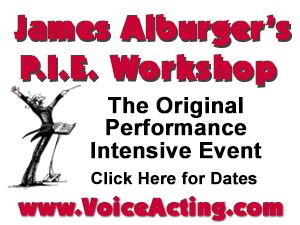|
AUDIOBOOKS Your Cure For Deadly Dull Non-Fiction Narrations: Flow With These Four 'Voices'  By Sean Pratt By Sean PrattNon-Fiction Audiobook Narrator and Coach One of the many reasons non-fiction narration tends to be so deadly dull, is that the narrator is working under the mistaken belief that all of the text on the page should be delivered in the same "voice" or style. Nothing could be further from the truth. I encountered this problem years ago when I began to record more and more non-fiction titles and was coming away dissatisfied with my performance. Though I was striving to make my general delivery as conversational as possible, I realized that it wasn't always a good fit with what I was actually seeing on the page. Chapter headings, lists, tables and quotes, as well as moments when the authors were really trying to stress the intellectual core of their thoughts - were moments that seemed to work against my "TED Talk-like" delivery. What to do? TAKE IT FROM SHAKESPEARE Soon thereafter, I attended an historical lecture on Shakespeare, given by a crackerjack professor. She not only had interesting ideas and concepts to present - and funny and insightful opinions to share - but she had created a PowerPoint presentation that was filled with film snippets of actors and directors giving quotes or telling anecdotes - and some VO guy voicing the bullet points and segments of her talk as they appeared onscreen. I loved the lecture. Yet something about the whole thing kept nagging at me. It's like that feeling you get when part of you recognizes an answer to a question you've been asking, but since it's in a different context you can't make the mental connection. Something in her presentation held the answer to my narrator's quandary, and it took me almost a month to figure it out. When I did, it totally changed the way I approached my non-fiction narration. FOUR DIFFERENT SEGMENTS It finally came to me that what the professor had done in her talk was to create, in effect, four different segments or parts that she moved between as needed. What made it so engaging was that she had clearly delineated the segments of her lecture; you always knew who was speaking or what was happening. I thought to myself, could I do that with just my voice? Could I change up the tone, style, inflection, volume, pacing, etc., to somehow inform the listener as to what I was seeing on the page? In effect, create four different "characters" or "voices"? It was worth a try! MY FOUR VOICES OF NON-FICTION NARRATION So after years of refining this idea, here are my four different voices of non-fiction. I use them when recording everything from history, to economics, to science, to - yes, even a book on Shakespeare. As you read this list, understand that when I narrate a book, I assume the identity and perspective of the author. 1. The voice of "Siri/Hal 9000" This flat, low and almost robotic voice is used for chapter headings and parts of chapters, enumerations, tables, etc. I use it to let the listener know we're moving into a new section of the book or getting into the weeds, as it were, with an illustration of some kind. 2. The voice of "confident authority" Strong, filled with gravitas, and deliberate in its delivery, this is me as the college professor telling the listener, "Here is the truth as I see it" - or perhaps, "This is going to be on the test, so you better write this down!" 3. The voice of "informed opinion" The most conversational and relaxed of the voices, here is where the majority of the "acting" in non-fiction lies. I share my feelings about the topic I'm discussing, reveal my sense of humor, or comment on a fact or statement I've just made. 4. The voice of the "Other" When I'm reciting from the Bible or Talmud, quoting someone whom the author has interviewed, or perhaps sharing an extended segment from another book, I change up the delivery and tone to signal to the listener that what they're hearing is something I didn't write. There is no one style attached to this voice, as it needs to change to fit the mood or tone of the text I'm quoting. LISTEN TO EXAMPLES ... GIVE IT A TRY So there you have it. The next time you're confronted with a non-fiction title that's giving you fits because your performance doesn't feel up to snuff, give this a try. It's worked for me through countless books, and I think it will give your narration greater clarity and drive, not to mention giving you a chance to polish your technique! One last thought. When I'm switching between these "voices" I usually take advantage of the short pause, as I'm mentally switching gears, to grab a catch breath in order to keep the overall flow of the narration moving forward at its proper tempo. ---------------------- ABOUT SEAN Sean Pratt has been a working professional actor in theater, film, TV and voice overs for over 30 years. He holds a BFA in Acting from Santa Fe University, NM. He has been an audiobook narrator for 19 years (aka – Lloyd James), recording over 850 books in almost every genre, and has received eight AudioFile Magazine "Earphones" awards and five "Audie" nominations from the Audio Publishers Association. He narrates for such companies as Blackstone Audiobooks, Tantor Media, Gildan Audio, Hachette, Random House, Penguin, and Christian Audio. Notable titles include A Death in the Family by James Agee, Infinite Jest by David Foster Wallace, Elvis in the Morning by William F. Buckley and Lindberg by A. Scott Berg. Currently, Sean coaches performers on audiobook narration technique. Email: seanpratt@comcast.net Web: www.seanprattpresents.com |
With Sean Daeley and Paul Stefano - check it out!
On Michael Langsner's Voice-Over Roadmap Podcast
Get your bi-weekly dose here ... all things VO!
For essential voice-over business strategies
As of the NEW website launch, 03/22/2012










1 - Read them in line with the text
2 - Move the sidebar to some other place in the chapter, then narrate them.
3 - NOT narrate them.
You would want to confirm with the Rights Holder.
The author, Nick Humphrey, quotes the viewpoints of assorted academics and sages - and these, I think, worked better for being rendered in mild tints of Scots, Oxford, American and so on. Yes, it needed extra research, not to mention some guesswork, but that made it all the more enjoyable to do and hopefully to hear.